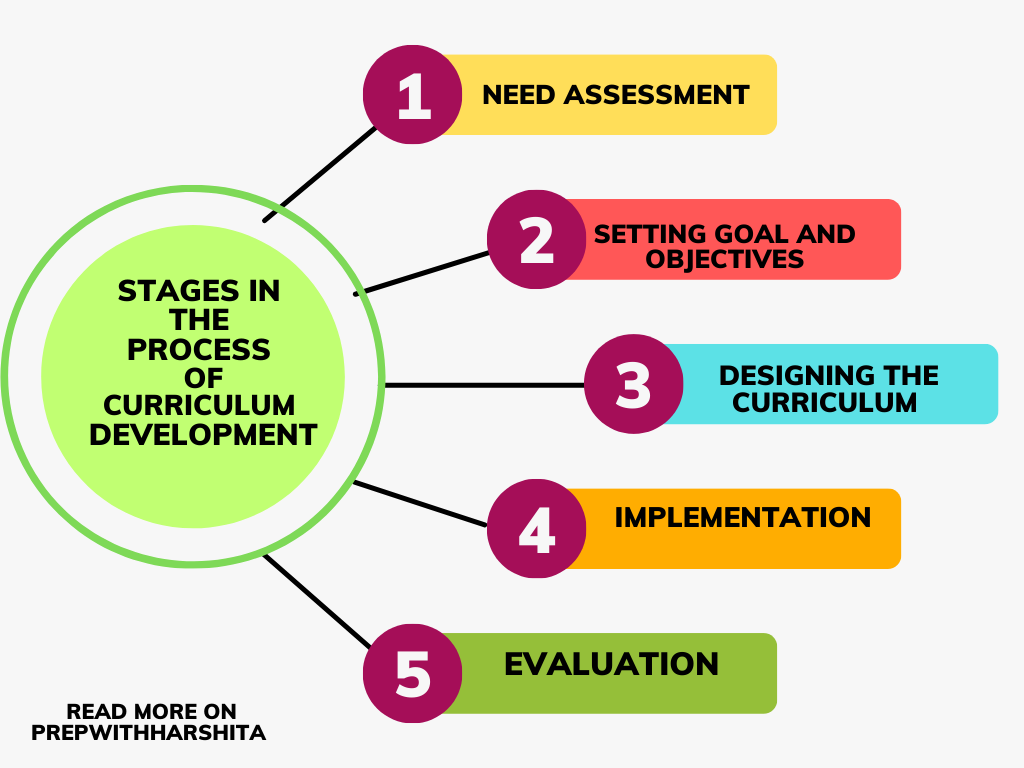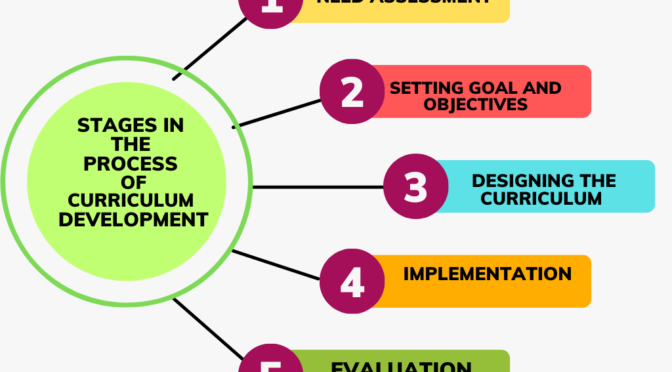The process of curriculum development typically involves several stages. The exact stages may vary depending on the specific context and needs of the educational institution or organization.
Following are some common stages in the process of Curriculum Development :
- Needs Assessment: The first stage of curriculum development involves identifying the current and future needs of the learners and the community. This stage requires gathering information from various sources such as students, teachers, parents, and other stakeholders to understand their needs, goals, and objectives. Needs assessment may involve conducting surveys, focus groups, interviews, or observations to collect data about the learners and the context in which the curriculum will be implemented.
- Setting Goals and Objectives: Based on the information gathered from the needs assessment stage, the goals and objectives of the curriculum are set. These should be specific, measurable, achievable, relevant, and time-bound (SMART). Setting goals and objectives helps to ensure that the curriculum is designed to meet the needs and goals of the learners and the community.
- Designing the Curriculum: Once the goals and objectives have been set, the curriculum is designed. This stage involves developing a framework for the curriculum, including the content, instructional strategies, assessment methods, and materials. The content should be aligned with the goals and objectives of the curriculum and should be organized in a logical and meaningful way. Instructional strategies should be selected based on the learning needs of the learners and the goals of the curriculum. Assessment methods should be aligned with the learning objectives and should provide meaningful feedback to learners.
- Implementation: In this stage, the curriculum is implemented in the classroom. Teachers and other educators use the curriculum to guide their instruction, and students engage with the content and activities. Implementation of the curriculum should be done in a systematic and consistent manner to ensure that the curriculum is delivered as intended.
- Evaluation: Once the curriculum has been implemented, it is evaluated to determine its effectiveness. Evaluation methods may include tests, surveys, observations, or other forms of assessment. The purpose of evaluation is to identify the strengths and weaknesses of the curriculum and make necessary adjustments.
- Revision: Based on the evaluation, the curriculum is revised and updated to improve its effectiveness. Revision may involve making changes to the content, instructional strategies, assessment methods, or materials. The revised curriculum should be aligned with the goals and objectives of the curriculum and should be designed to meet the needs of the learners and the community.
- Implementation of revised curriculum: Once the revisions have been made, the revised curriculum is implemented in the classroom. The evaluation and revision cycle continues as the curriculum is continuously monitored and updated to ensure that it remains effective.
It’s important to note that the process of curriculum development is an iterative process, and the stages may not always follow a linear sequence. Additionally, there may be additional stages or steps depending on the context and specific needs of the educational institution or organization.
Also Read : Curriculum Change

Also Visit : Prep with Harshita


Very easy & appropriate language
Thank you for this….
equilibrado de turbinas
Aparatos de equilibrado: fundamental para el funcionamiento uniforme y óptimo de las maquinarias.
En el campo de la ciencia moderna, donde la efectividad y la seguridad del sistema son de alta importancia, los sistemas de equilibrado juegan un papel fundamental. Estos equipos adaptados están concebidos para calibrar y regular componentes dinámicas, ya sea en dispositivos manufacturera, automóviles de desplazamiento o incluso en electrodomésticos caseros.
Para los técnicos en mantenimiento de equipos y los técnicos, operar con sistemas de equilibrado es importante para garantizar el funcionamiento estable y seguro de cualquier aparato móvil. Gracias a estas soluciones tecnológicas sofisticadas, es posible limitar notablemente las vibraciones, el estruendo y la tensión sobre los soportes, prolongando la tiempo de servicio de elementos importantes.
También importante es el papel que desempeñan los dispositivos de equilibrado en la servicio al usuario. El ayuda experto y el reparación continuo usando estos equipos facilitan proporcionar soluciones de óptima excelencia, elevando la bienestar de los consumidores.
Para los responsables de emprendimientos, la contribución en equipos de balanceo y sensores puede ser clave para mejorar la rendimiento y rendimiento de sus aparatos. Esto es especialmente importante para los dueños de negocios que manejan medianas y pequeñas organizaciones, donde cada aspecto vale.
Por otro lado, los equipos de calibración tienen una gran utilización en el campo de la seguridad y el control de nivel. Permiten detectar eventuales fallos, evitando arreglos onerosas y perjuicios a los dispositivos. También, los datos obtenidos de estos equipos pueden aplicarse para perfeccionar procedimientos y mejorar la presencia en sistemas de consulta.
Las sectores de uso de los equipos de balanceo cubren diversas industrias, desde la fabricación de ciclos hasta el control ecológico. No importa si se considera de grandes fabricaciones de fábrica o reducidos talleres hogareños, los equipos de calibración son indispensables para asegurar un funcionamiento óptimo y sin paradas.
I think other web site proprietors should take this web site as an model, very clean and wonderful user friendly style and design, let alone the content. You’re an expert in this topic!
When I originally commented I clicked the -Notify me when new comments are added- checkbox and now every time a remark is added I get four emails with the identical comment. Is there any means you’ll be able to take away me from that service? Thanks!
I do not even know how I ended up here, but I thought this post was great. I don’t know who you are but certainly you’re going to a famous blogger if you aren’t already 😉 Cheers!
[b]Prevent Vibration Damage – Get Professional Balancing with Balanset-1A[/b]
Unbalanced rotors can cause serious damage to your machinery. Bearings wear out faster, motors consume more power, and failures lead to expensive repairs. [b]Balanset-1A[/b] provides professional-grade vibration diagnostics and balancing, helping businesses save money and improve reliability.
[b]Key Benefits:[/b]
– [b]Accurate & fast diagnostics[/b] – Identifies imbalance before it causes damage
– [b]Portable & efficient[/b] – Suitable for field and workshop use
– [b]User-friendly software[/b] – No special training required
[b]Choose Your Kit:[/b]
[url=https://www.amazon.es/dp/B0DCT5CCKT]Full Kit on Amazon[/url] – Includes all necessary sensors, software, and a protective case
Price: [b]€2250[/b]
[url=https://www.amazon.es/dp/B0DCT5CCKT][img]https://i.postimg.cc/SXSZy3PV/4.jpg[/img][/url]
[url=https://www.amazon.es/dp/B0DCT4P7JR]OEM Kit on Amazon[/url] – More affordable, comes with basic components
Price: [b]€1978[/b]
[url=https://www.amazon.es/dp/B0DCT4P7JR][img]https://i.postimg.cc/cvM9G0Fr/2.jpg[/img][/url]
Protect your equipment today with [b]Balanset-1A[/b]!
I have realized that car insurance corporations know the cars which are vulnerable to accidents and various risks. Additionally , they know what types of cars are given to higher risk and also the higher risk they have got the higher your premium charge. Understanding the very simple basics associated with car insurance can help you choose the right types of insurance policy that should take care of the needs you have in case you get involved in any accident. Many thanks sharing a ideas in your blog.
Whats up are using WordPress for your site platform? I’m new to the blog world but I’m trying to get started and create my own. Do you require any coding knowledge to make your own blog? Any help would be greatly appreciated!